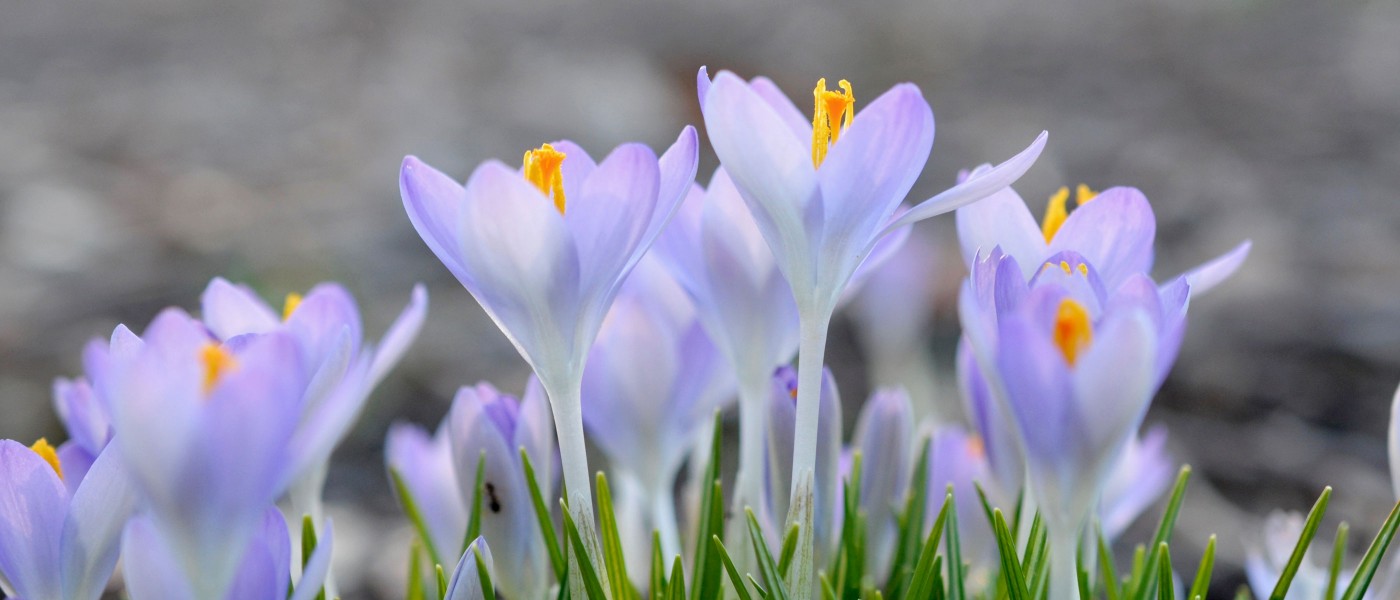Early-Spring Highlights
Magnolias, cherry blossoms, lilacs and more dot the Garden in early spring. Here are some of the highlights.
Magnolia Plaza and Daffodil Hill: Spring’s Favorite Flowers
The pink, white, and yellow blossoms of Magnolia Plaza are spectacular in the spring. Some trees are also living pieces of BBG’s history, having been developed in the Garden’s breeding program. The earliest trees usually start to bloom in late March, and the rest of the collection follows in April.
Look for
- Early-blooming, “naked” yulan magnolias. These trees are precocious bloomers, which means flowers appear before the leaves. The creamy blooms are among the first to appear, in late March.
- Saucer magnolias. These popular hybrid magnolias produce gorgeous pink and white blossoms on bare branches (they're also precocious bloomers), some as large as eight inches in diameter. There are a dozen on Magnolia Plaza, and they bloom around the same time as the yulan.
- Magnolia ‘Elizabeth’. This pale, yellow-blossomed hybrid, in the Osborne Garden, was the first of the renowned yellow magnolia cultivars bred at BBG. It’s a cross between a yulan magnolia and an American cucumber tree.
Also be sure to see Daffodil Hill, next to the plaza on the north side. Get up close and notice the difference in color, size, and shape among the multitude of blossoms. There are dozens of species and cultivars here, representing ten different daffodil divisions.
Japanese Hill-and-Pond Garden: Cherry Blossoms and More
This garden was designed to highlight the changing seasons, and it’s one of the best places to see ornamental cherries in their full splendor. They bloom throughout April and often into early May, with each cultivar taking a week or two to progress through its bloom cycle.
Look for
- Weeping higan cherry trees. These pink-blossomed trees have gracefully weeping branches and are among the earlier-blooming cultivars at BBG.
- Single-blossom Yoshino cherries. This ornamental cherry—the most popular in Japan—has flowers that begin as pink buds and open to reveal snowy-white petals. There are several Yoshino trees in the Garden, one lovely example just west of the amphitheater, and they bloom in the middle of cherry season, usually in mid-April.
- Early-blooming azaleas. Among the most common plants seen in Japanese gardens, azaleas—particularly evergreen varieties—provide both structure and spring color. Look for magenta-flowered Kirishima azaleas along the path between the pavilion and the waiting bench and white-blossomed snow azaleas near the shrine.
The garden’s designer, Takeo Shiota, created this stroll garden to be both viewed from a distance and explored on foot. Enjoy the individual plants up close and the beautiful spring vistas from different vantage points along the path.
Native Flora Garden: Woodland Wildflowers
In early spring, before the trees leaf out, woodland wildflowers take advantage of the sunlight to bloom. These plants, sometimes called spring ephemerals, complete their bloom cycle in just a few weeks, or even less.
Look for
- Several species of trillium. These are some of the most distinctive woodland flowers—they have petals that appear in threes or multiples of three. Depending on the species, the blossoms may be white, burgundy, or yellow.
- Dutchman’s-breeches. In mid- to late April, look for arching stems of delicate white flowers amid clumps of lacy green foliage. The flowers resemble little pantaloons and are closely related to the pink-flowered bleeding heart, another native species that blooms here at this time.
- Bloodroot. Bloodroot flower buds emerge wrapped in crinkly green leaves, waiting for a warm, sunny day to burst open, revealing showy white petals. Truly ephemeral, the blossoms are usually only around for a few days before the petals fall into a heap.
Look for clumps or patches of these and other spring flowers along the path just inside the wooden gate, near the limestone ledge area, and throughout the deciduous forest area of the Native Flora Garden.
Also see
A charming selection of spring blooms from literature, including tulips, primroses, dwarf irises, forget-me-nots, and violets, in the Shakespeare Garden.
The spectacular yearly display of bulbs in the Annual Border on Lily Pool Terrace. Each year’s design is unique!
Crocuses, hellebores, daffodils, anemones, and other low-growing alpine plants, plus many early azaleas, in the Rock Garden.
And stay tuned for later spring blooms: peonies, wisteria, crabapples, Spanish bluebells, and more cherries!
More: Late-Spring Blooms

